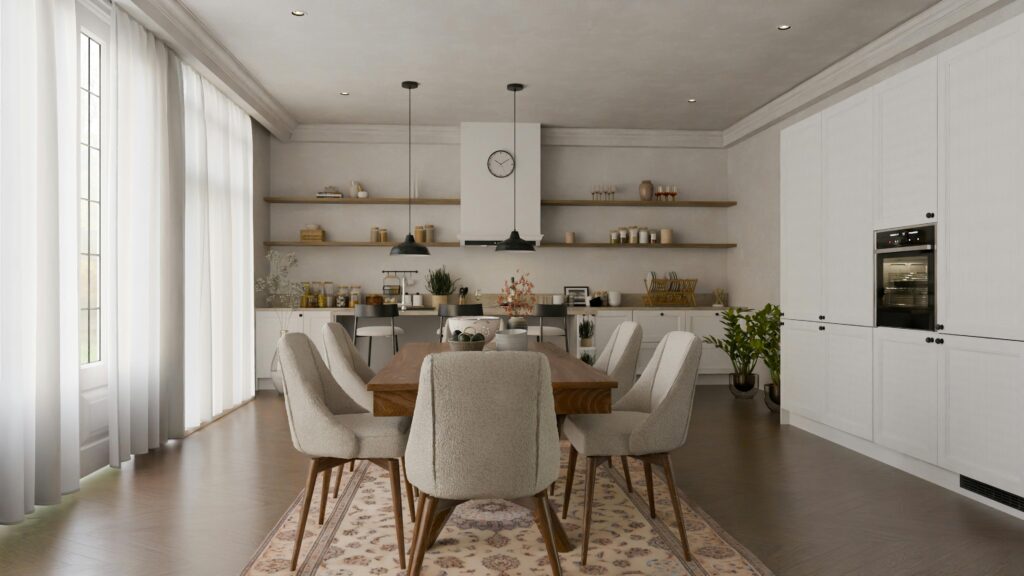Middle Eastern design is a treasure trove of cultural richness, blending history, artistry, and elegance. For homeowners in the UAE, integrating these timeless elements into modern interiors offers a unique opportunity to celebrate heritage while embracing contemporary living. Whether you’re captivated by the intricate arabesque patterns or the luxurious textures of traditional fabrics, this guide will show you how to fuse Middle Eastern aesthetics with modern design seamlessly.

1. Start with a Statement Piece
Every memorable interior begins with a focal point that draws the eye. In Middle Eastern-inspired design, this could be a hand-carved wooden screen, a vibrant kilim rug, or an ornate chandelier dripping with craftsmanship. These pieces anchor the room and set the tone for the entire space. To keep the look modern, pair your statement piece with sleek, minimalist furniture—think a low-profile sofa or a glass coffee table—to create a striking contrast that feels fresh yet rooted in tradition.
If you’re not ready to commit to a large piece, start small. A mosaic mirror or a cluster of brass lanterns can introduce Middle Eastern flair without overwhelming the room.
2. Embrace Rich Colors and Textures
Middle Eastern design thrives on bold, warm colors—deep reds, golds, turquoise blues—that evoke a sense of opulence. In a modern home, use these hues strategically to avoid overpowering the space. Paint an accent wall in a rich terracotta shade or scatter jewel-toned cushions across a neutral sofa. The key is balance: let these colors shine as highlights rather than the main event.
Textures are just as vital. Layer materials like silk, velvet, and wool to add depth and luxury. Picture a velvet-upholstered chair draped with a woven throw or a silk canopy softening a bedroom corner—small touches that elevate the everyday into the extraordinary.
3. Incorporate Intricate Patterns
Patterns are the soul of Middle Eastern design, from geometric tiles to swirling floral motifs. These designs can transform a plain space into a work of art, but in a modern context, restraint is key. Opt for a single patterned feature—like a tiled backsplash in the kitchen or a wallpapered accent wall—to add character without clutter. For a bold yet balanced look, pair traditional patterns with contemporary furniture, such as a sleek dining table surrounded by chairs upholstered in a heritage-inspired fabric.
4. Highlight Artisanal Craftsmanship
The Middle East has a long tradition of artisanal mastery, and incorporating handmade pieces brings authenticity to your home. A hand-painted ceramic vase, a carved wooden coffee table, or a woven basket not only enhances your decor but also supports local craftspeople. These items carry stories of skill and tradition, making your space feel personal and unique.
At DPAM Interiors, we partner with UAE artisans to offer exclusive, handcrafted furniture and decor that marry tradition with modern functionality—perfect for those seeking something truly special.
5. Balance Tradition with Modernity
The magic of this design approach lies in balance. Too many traditional elements can feel heavy or dated, while too few might lose the cultural essence. Aim for harmony: pair a modern sectional sofa with a vintage rug, or hang minimalist art alongside traditional lanterns. This interplay creates a dynamic, layered aesthetic that’s both timeless and forward-thinking.
Conclusion
Blending Middle Eastern design with modern interiors is about more than just looks—it’s a celebration of heritage meeting innovation. By choosing statement pieces, playing with color and texture, and honoring craftsmanship, you can craft a home that’s both culturally resonant and refreshingly contemporary. Ready to transform your space? Explore DPAM Interiors’ curated collections or schedule a consultation with our design experts today. We’d love to hear your thoughts—share them in the comments below!
